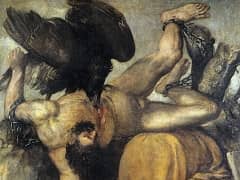Venus and Lute Player, 1360 by Titian

Venus and the Lute Player, the culmination of Titian's long concern with the theme of the reclining nude goddess, exists in two versions: this one in Cambridge, which is the more
finished, and the canvas in The Metropolitan Museum of Art in New York, which remained in the studio as a ricordo, a record of the composition fully blocked in but still incomplete.
(After the death of the master it may have been among the pictures acquired by Tintoretto, and eventually it was given some finishing touches by another hand, possibly that of Tintoretto's
son Domenico.) The Cambridge painting was in the collection of Emperor Rudolf II at Prague, where it is recorded in an inventory of 1621.
A celebration of love - whose object is beauty and whose means of expression are poetry and music - the composition offers a pictorial summa of Renaissance conventions of courtship; mixing
the real and the ideal, nature and art, its highly cultivated aesthetic controls and sanctions its obvious erotic appeal. The musician-courtier, in fashionable sixteenth-century attire,
serenades his beloved - or rather the sensual symbol of all beloveds, Venus herself. A narrative line extends from left to right, carried especially by his fervent glance in the direction of
the head of Venus; crowned by Cupid, she gazes upward, toward a higher realm. Paying homage to Neoplatonic concepts, Titian creates a Triumph of Love that acknowledges the various levels of
that power, from the earthly to the heavenly, from human passion to divine love. "There are three kinds of beauty," Marsilio Ficino had written in his commentary on Plato's Symposium,
"that of the souls, that of the bodies, and that of sounds; that of the souls is perceived by the mind, that of the bodies we perceive through the eyes, that of sounds through the ears; love
is always content with the mind, the eyes, and the ears."
Titian's picture is, above all, a full sensuous experience, a direct appeal to those senses approved by Ficino - as well as to the "lower" sense of touch, always a crucial mode of experience
in this painter's art. But Venus and the Lute Player is hardly an illustration of abstract doctrine. It is a social image in the widest sense, in which a human action unfolds in time,
articulated and measured - as so often in Titian's work - by music. The partbooks are open; the courtier sings a madrigal to the accompaniment of the lute, while the goddess herself still
holds the recorder that she was playing a moment ago. Music, spanning past, present, and future, is the basic means of expression, articulating time; its harmonies serve as the fundamental
unifying medium; its theme is, as it must be, love. As Titian's friend Aretino wrote, with regard to women, "the knowledge of playing musical instruments, of singing, and of writing
poetry ... is the very key which opens the gates of their modesty."
There is still a further dimension to Titian's picture, for beyond narrating the special rapport between musician and goddess, the painting also addresses the observer directly. Quite
obviously, the lush nude is turned frontally, with studied artifice, for the viewer's delectation. Moreover, the viola da gamba propped as a repoussoir device in the lower right corner and
extending beyond the space of the picture, awaiting its player, implicitly invites us to join the concert, to participate fully in the adoring perception of beauty.















